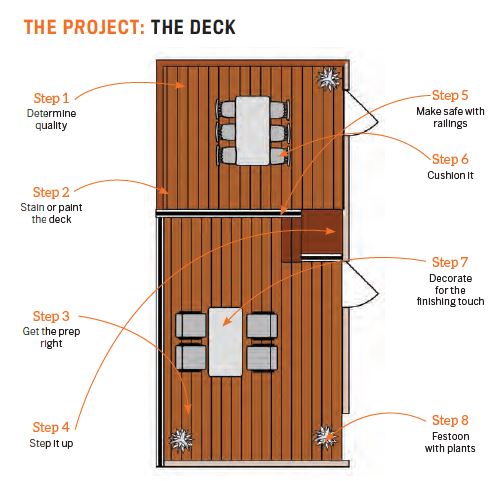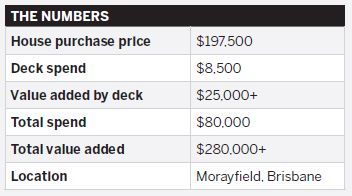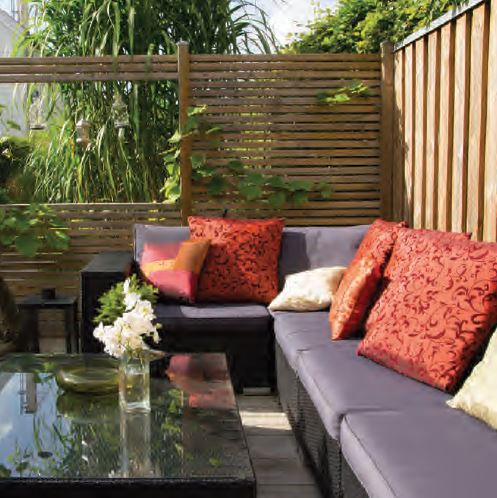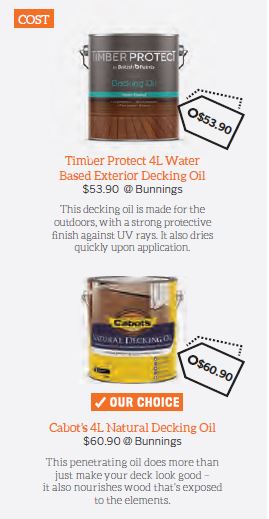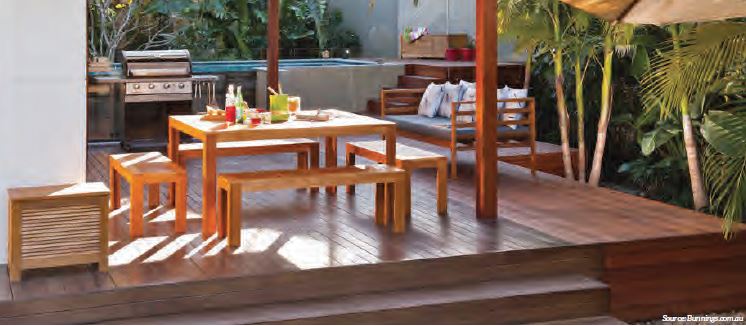12/04/2018
A spectacular house isn't just about what's inside: it's also what's on the outside that counts. When it comes to the backyard, a well-designed deck can add function and additional space, creating a highly sought-after ‘extra’ entertainment zone.
Especially during the warm summer months, there’s no better place to admire a beautiful view than from your own backyard. That’s why additional entertainment areas, like a smart deck area, can increase the value of your investment property so much, as they add usable, functional square metres to your home’s footprint.
If you’re making significant structural changes to an outdoor space, the first thing you should do is check whether you need approval from your local council.
Different councils have varying sets of rules with regard to what kinds of permits are required, but typically you would need planning and building permits for largerscale projects, such as areas over 10sqm.
Planning and building permits will give you guidance on the rules and regulations regarding aesthetics and boundaries. Your local council may enforce compliance with certain rules of construction, and running afoul of these guidelines can be costly to rectify.
Note that if you’re making changes to an existing deck or outdoor area, permits may not be necessary. However, it’s better to be safe than sorry, so when planning a deck renovation be sure to get the research process underway as soon as possible.
When renovating a deck space, it’s best to start from the bottom up,because the state of the foundations can be crucial.
If the foundations are in good condition, you may just save yourself a pretty penny!
"If you’re making significant structural changes to an outdoor space check to see if you need approval from your local council"
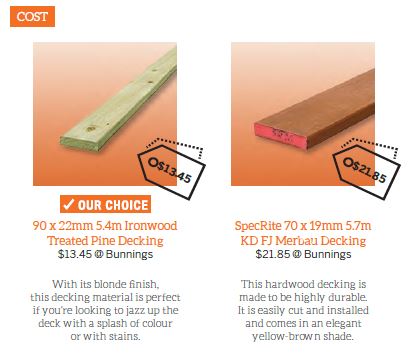
Though decks can be made of different surfaces, including tile, wood is usually the more popular option, given its warmth, durability and classic aesthetic.
Quality is important here since it’s not just the look but the strength of your foundation that counts. Wood can be subject to conditions such as wood rot, where the material goes soft and can be jostled with little effort. Being an outdoor space, extreme heat, sunlight and rain can also hit timber with some serious wear and tear, causing boards to loosen and nails to pop. All these things need to be considered when reviewing your options.
TOP TIP
Treated pine is the most basic and affordable option and is ideal for most investment properties. Note that wooden decks should ideally be cleaned and resealed every 12 months to preserve their quality and condition.
STEP TWO: STAIN OR PAINT THE DECK
To strengthen wood further while adding a new dimension to its appearance, you can stain or paint the deck.
Staining can help protect wood from UV damage and retain its natural wood look, while paint has stronger protective qualities.
Before you add a new coating, however, old treatments must be scrubbed off completely, using a designated stain or paint remover, so that you’re working with the original material.
Decking oil also protects wood from the elements by moisturising it and helping to fight decay.
As with stains, oils can be tinted or clear – tinted ones can alter the tone of wood completely.
TOP TIP
In certain circumstances, you may want to avoid a stain or oil altogether, instead leaving the wood to ‘grey off’. This exposed, rustic look works well on smaller areas but can lead to faster wood deterioration.

There’s a lot of preparation involved in painting a deck, so you should not scrimp on this stage of the process.
The first step is sanding – a good electric sander is the best tool you can use as it can sand large areas at speed to strip away any previous treatments of the wood. These can be hired to avoid the large investment of buying one yourself.
Once the deck is perfectly even and well sealed with exterior-grade putty, apply a good oil-based primer, followed by oil-based paint made specifically for exterior use. A paint roller can be used on most of the surface, and a paintbrush for tricky spots such as the gaps between boards and around posts.
TOP TIP
You don’t need to be a pro to get the painting and/or staining of your deck right, but you do need to be particularly careful during application: accidental spots and drips can leave unsightly marks that won’t blend in.
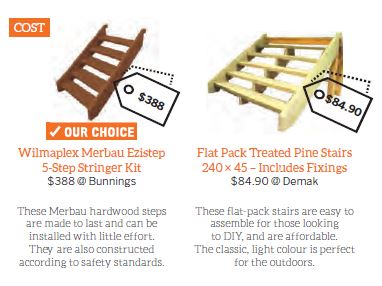
A deck area should ideally be above ground level, as this separates it from the rest of the yard. As a result, a set of stairs is necessary for both form and safety reasons.
Wooden stairs generate a rich, warm atmosphere, but they also require more maintenance. Steel stairs can stand up against many conditions, including termites, and are versatile in terms of look – they can evoke vintage, contemporary and industrial looks. Budget will likely impact your decision when it comes to steps or a staircase.
TOP TIP
Safety comes first, as the saying goes, and that’s never more important than when you’re constructing a deck on an investment property. To prevent accidents on the stairs, be sure to put down non-slip strips.
STEP FIVE: MAKE SAFE WITH RAILINGS
Railings are an essential safety feature to place around your deck, to ensure that no one accidentally gets hurt. They also provide additional support if you have stairs, as they can help prevent slipping.
Make sure the railings can’t be climbed easily, especially by small children, and secure the deck entrance with a childproof gate to prevent accidents.
Railings are not just functional – they can enhance the look of the deck, depending on how you style it. For instance, glass panels evoke modernity, whereas wooden posts are more traditional and classic. Metal railings are easy to work with and simple to maintain.
TOP TIP
If you have a pool area near the deck, you’ll need to ensure your deck fence or railings meet relevant legal standards. This may require a vertical design, rather than horizontal, to avoid the risk of a person climbing the fence/railing and accessing the pool.

Nothing exudes comfort like an outdoor room with lovely fluffy pillows. Pillows and cushions make a space feel more casual and homey and can complement the rest of the deck design at little cost. Brightly coloured cushions can serve as a focal art piece, as well as upping the cosy atmosphere.
Ensure that your chosen pillows are made of outdoor fabric so they stand up against the elements. A washable protectant can help keep moisture and stains from building up, and spray-on seal for outdoor fabrics can protect your pillows for years to come.
TOP TIP
If you’re renovating your deck for a rental property, finishing touches such as furniture or cushions may not be necessary. However, consider adding them as staging elements for the photos: they really sell the lifestyle and can help you attract an A-list tenant.

Turn the deck into an entertainment space by jazzing it up with furniture. Put out lounge chairs and low tables to create a chill spot. Set up an umbrella to provide relief from the sun, and have storage benches lying around to perform dual functions by serving as both storage units and something to sit on.
Synthetic wicker or resin wicker furniture is the most durable kind of material for outdoor furniture because it is resistant to poor weather conditions while maintaining the look of natural wicker. If you’re looking at wood, teak is a great option as it produces natural water-repelling oil.
TOP TIP
Again, if your deck renovation is for an investment property, you may not need to go the extra mile and install furniture. However, keep in mind that if you do, tax deductions and depreciation benefits may be at play.

A great way to brighten up a deck is to have plants. With a collection of potted plants, you can get your own garden going. Shrubs grown in containers are perfect for small spaces, and you can use pots of different designs to get varying looks. You can also opt for garden boxes.
A well-placed vine can create a great aesthetic while providing extra cover. However, make sure that you know what plants you’re buying and the level of care they require, because they can be affected by the container they’re grown in.
TOP TIP
There’s nothing sadder than a deck full of dying plant life, so don’t splash out on extended greenery for an investment property. You never know if the tenant has a green thumb or not, so your plants could expire before they’ve had a chance to thrive.

